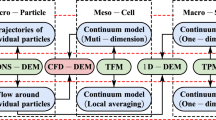Abstract
In this study, the 2D shallow water equations (SWE) are solved using a meshless method with the local polynomial approximation and the weighted-least-squares (WLS) approach. Three challenging dam-break flow problems are chosen to test the 2D meshless SWE model. The focus of this study is on the capability of simulating the shallow water flows with moving wet/dry fronts and large bottom slopes. Mass conservation, which is a very important concern in the wet/dry front problems, is carefully examined. Modification of the previous work on improving mass conservation is presented in this study. Computed results are compared with experimental data. The results show that the refined model can effectively simulate the flooding and drying with steep slopes in the topography.












Similar content being viewed by others
References
Hardy RL (1971) Multiquadric equations of topography and other irregular surfaces. J Geophys Res 76(8):1905–1915
Franke R (1982) Scattered data interpolation: tests of some methods. Math Comput 38:181–199
Farwig R (1986) Multivariate interpolation of arbitrarily spaced data by moving least squares methods. J Comput Appl Math 16(1):79–93
Kansa EJ (1990) Multiquadrics–a scattered data approximation scheme with application to computational fluid-dynamics- I. Surface approximations and partial derivative estimates. Comput Math Appl 19(8–9):127–145
Sun C-P, Young DL, Shen L-H, Chen T-F, Hsian CC (2013) Application of localized meshless methods to 2D shallow water equation problems. Eng Anal Bound Elem 37:1339–1350
Hon Y-C, Cheng KF, Mao X-Z, Kansa EJ (1999) Multiquadric solution for shallow water equations. J Hydraul Eng ASCE 125(5):524–533
Wong SM, Hon Y-C, Golberg MA (2002) Compactly supported radial basis functions for shallow water equations. Appl Math Comput 127(1):79–101
Alhuri Y, Naji A, Ouazar D, Taik A (2010) RBF based meshless method for large scale shallow water simulations: experimental validation. Math Model Nat Phenom 5(7):4–10
Chou CK, Sun CP, Young DL, Sladek J, Sladek V (2015) Extrapolated local radial basis function collocation method for shallow water problems. Eng Anal Bound Elem 50:275–290
Li PW, Fan CM (2017) Generalized finite difference method for two-dimensional shallow water equations. Eng Anal Bound Elem 80:58–71
Chang T-J, Kao H-M, Chang K-H, Hsu M-H (2011) Numerical simulation of shallow-water dam break flows in open channels using smoothed particle hydrodynamics. J Hydrol 408(1–2):78–90
Kao H-M, Chang T-J (2012) Numerical modeling of dambreak induced flood and inundation using smoothed particle hydrodynamics. J Hydrol 448–449:78–90
Vacondio R, Rogers BD, Stansby PK, Mignosa P (2013) A correction for balancing discontinuous bed slopes in two-dimensional smoothed particle hydrodynamics shallow water modeling. Int J Numer Methods Fluids 71(7):850–872
Chen R, Shao S, Liu X, Zhou X (2015) Applications of shallow water SPH model in mountainous rivers. J Appl Fluid Mech 8(4):863–870
Gu S, Zheng X, Ren L, Xie H, Huang Y, Wei J, Shao S (2017) SWE-SPHysics simulation of dam break flows at South-Gate Gorges Reservoir. Water 9(6):387
Löher R, Sacco C, Oñate E, Idelssohn S (2002) A finite point method for compressible flow. Int J Numer Methods Eng 53(8):1765–1779
Perazzo F, Löher R, Perez-Pozo L (2008) Adaptive methodology for meshless finite point method. Adv Eng Softw 39(3):156–166
Wu N-J, Chen J, Tsay T-K (2016) Application of weighted-least-square local polynomial approximation to 2D shallow water equation problems. Eng Anal Bound Elem 68:124–134
Morris M (2000) CADAM: concerted action on dambreak modeling—final report. Rep. SR 571; HR Wallingford, UK
Brufau P, Vázquez-Cendón ME, García-Navarro P (2002) A numerical model for the flooding and drying of irregular domains. Int J Numer Methods Fluids 39(3):247–275
Brufau P, García-Navarro P (2003) Unsteady free surface flow simulation over complex topography with a multidimensional upwind technique. J Comput Phys 186(2):503–526
Delis AI, Katsaounis Th (2005) Numerical solution of the two-dimensional shallow water equations by the application of relaxation methods. Appl Math Model 29(8):754–783
Nikolos IK, Delis AI (2009) An unstructured node-centered finite volume scheme for shallow water flows with wet/dry fronts over complex topography. Comput Methods Appl Mech Eng 198(47–48):3723–3750
Kleefsman KMT, Fekken G, Veldman AEP, Iwanowski B, Buchner B (2005) A volume of fluid based simulation method for wave impact problems. J Comput Phys 206(1):363–393
Funding
The authors would like to thank the financial support from the Ministry of Science and Technology, Taiwan (grant numbers: MOST-106-2221-E-415-007-).
Author information
Authors and Affiliations
Corresponding author
Rights and permissions
About this article
Cite this article
Hsu, TW., Liang, SJ. & Wu, NJ. Application of meshless SWE model to moving wet/dry front problems. Engineering with Computers 35, 291–303 (2019). https://doi.org/10.1007/s00366-018-0599-1
Received:
Accepted:
Published:
Issue Date:
DOI: https://doi.org/10.1007/s00366-018-0599-1




